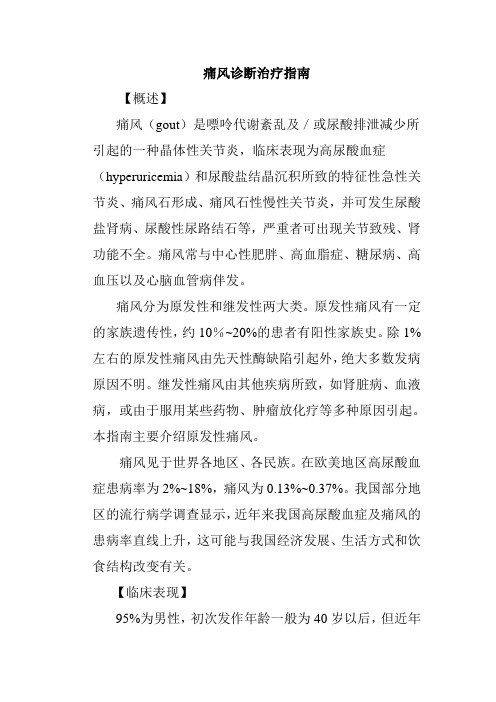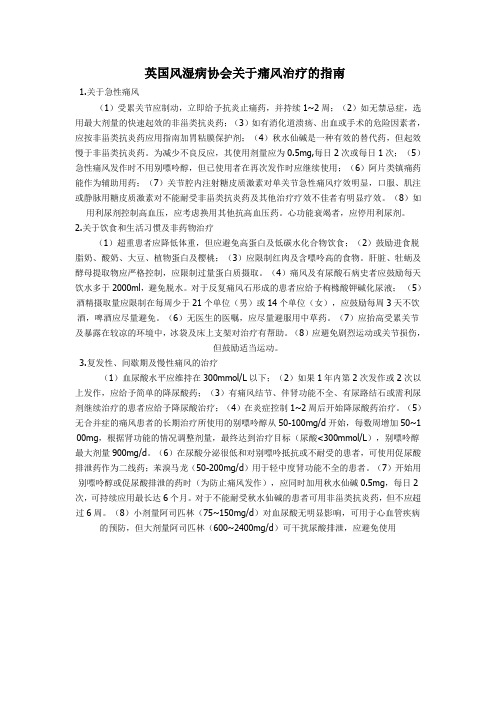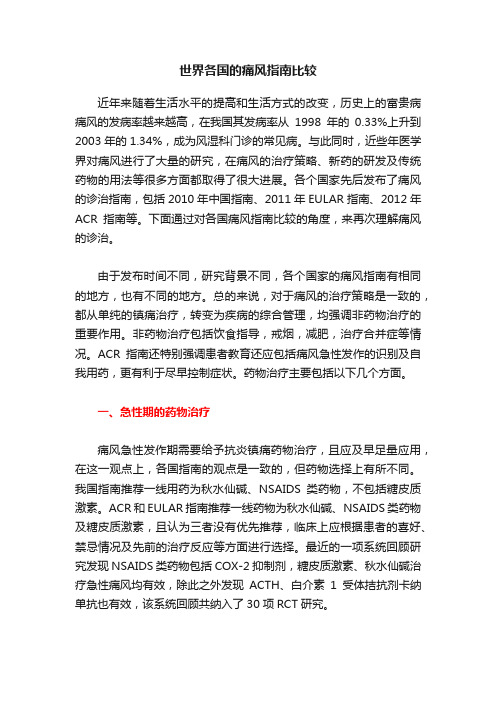2007英国风湿病学会痛风指南
英国痛风治疗指南 2007—粗翻译版

英国社会的风湿病风湿病和英国卫生专业人员指导管理痛风关键词:痛风、指导方针、后备治疗,药物治疗。
范围和目的的指导方针痛风是一种常见的疾病在初级保健和医院实践[1]。
虽然药物治疗痛风已成为一个范例的有效管理和预防急性和潜在的慢性风湿性疾病,治疗的许多建议是基于专家的共识,而不是研究证据和审计的实践表明,治疗是非常变量。
以证据为基础的指导方针需要目前:●为提高护理标准提供了一个框架●评估潜在的新疗法,如Coxibs[2],尿酸盐氧化酶类小说[3]和黄嘌呤氧化酶抑制剂目前[4]在临床发展;●提供建议饮酒,饮食和生活方式修改,以应对由患者常见问题()在最近的流行病学研究痛风与酒精消费[5],膳食蛋白质摄入量[6]和代谢综合征的特点,假设流行比例[7];●定义建议治疗次要的非典型痛风,和小相关联的子严重痛风复发患者肾功能不全,器官移植、别嘌呤醇过敏或主嘌呤生产过剩。
目标已经开发简洁、以患者为焦点、以证据为基础的建议管理痛风在初级保健医生和盟军的健康专家和医院实践在英国,这也将为患者提供一个有用的资源。
对痛风的诊断和调查的建议[8]不解决。
管理方针痛风这是一个简短的摘要的指导方针。
可以访问完整的指南在风湿病学在线()。
总结了管理途径提出了相应的流程图。
强度的建议,基于证据的水平,分级a - c[9],和建议分为三个部分:管理的急性痛风:1.影响关节应该休息(C)、镇痛、抗炎药物治疗立即开始,并持续1 - 2周(A)。
2.快速口服非甾体类抗炎药在最大剂量的药物选择当没有禁忌症(A)。
3.患者的风险增加消化性溃疡、出血或穿孔,它胃粘膜保护剂代理应该遵循标准的非甾体抗炎药的使用指南和昔布类(A)。
4.秋水仙碱可以有效替代但比非甾体抗炎药缓慢的工作。
(A)。
为了减少不利影响的风险(尤其是腹泻)它应该使用剂量的500 μg bd-qds(C)。
5.别嘌呤醇不应该开始在急性发作患者(B),但已经建立在别嘌呤醇,它应该继续和急性发作应常规治疗(A)。
英国风湿病学会痛风管理指南(最全版)

英国风湿病学会痛风管理指南(最全版)自2007年英国风湿病协会(The British Society for Rheuma-tology,BSR)曾经发表过痛风治疗的指南[1]之后,新型治疗痛风的药物以及治疗相关证据不断出现。
2017年BSR小组根据系统文献综述以及投票提出了新的痛风管理指南[2],主要针对痛风急性发作的管理,改变生活方式和风险因素,优化降尿酸治疗等内容提出推荐意见。
该建议于2017年5月在Rheumatology正式刊出。
在此,我们将其中的主要内容摘录总结,希望能够指导痛风的治疗。
1 急性痛风发作的管理2017年BSR小组给出6项推荐建议,具体如下:①对患者进行教育,一旦有痛风发作,应立即采取治疗措施。
确保患者知晓发作期间继续已接受的降尿酸治疗(ULT)的重要性[证据水平(LoE)Ⅳ,推荐强度(SOR)90%]。
②受累关节应得到休息,可将受累的关节抬高,进行冷敷:床架和冰袋是有效的治疗辅助工具(LoEⅠb(冰袋)、LoE Ⅳ(其他),SOR 89%)。
③在没有禁忌证的情况下,最大剂量的NSAIDs或秋水仙碱500 μg每日2~4次是可选择的方案:一线药物的选择取决于患者意愿、肾功能和合并症。
服用NSAIDs或环氧化酶-2抑制剂(coxibs)的患者应同时服用胃保护剂(LoE Ⅰa,SOR 95%)。
④关节腔抽液和注射糖皮质激素对急性单关节痛风患者有明显疗效,也可用于治疗有急性疾病和合并症的患者:对于不能耐受NSAIDs或秋水仙碱的患者,以及无法进行关节腔内注射的患者,短期口服糖皮质激素或单次肌肉注射糖皮质激素可作为一种替代方案;这种全身治疗也适用于少关节或多关节痛风发作[LoEⅠb(口服)、Ⅲ(关节腔、肌肉注射)、Ⅳ(少关节或多关节痛风发作),SOR 94%]。
⑤单药治疗效果不佳的急性痛风患者,可以使用联合治疗(LoE Ⅳ,SOR 80%)。
⑥对于既往治疗中发现标准方案疗效不佳的急性痛风患者,可考虑IL-1抑制剂(但还未得到NICE的批准)[LoE Ⅰb:康纳单抗(canakinumab),利纳西普(rilonacept),Ⅲ:阿那白滞素(anakinra),SOR 61%]。
医学专题痛风和高尿酸血症诊治指南解读

有痛风石者SUA达标后6个月
第二十六页,共三十页。
EULAR:小剂量秋水仙碱 一线药物 小剂量NSAIDs或小剂量GS 二线药物 降尿酸药物使用(shǐyòng)前2周开始,持续时
间根据患者情况而定
日本:小剂量秋水仙碱
台湾:小剂量秋水仙碱,持续时间3-6个月 风湿:小剂量秋水仙碱或NSAIDs,持续时间至少1个 月
89%)。
第八页,共三十页。
适用标准:至少一次外周关节或滑囊肿胀、疼痛、 压痛
确定标准:证实关节或滑囊存在尿酸钠晶体
分类标准:累计≥8分可诊断
临床特点
受累关节分布:曾有急性发作的关节/滑囊部位 (单或寡关节炎) 踝关节或足部(非第一跖趾关节)受累 第一跖趾关节受累
受累关节急性发作时症状:1.皮肤发红(患
(1mg/dL=60µmol/L)
人体(réntǐ)正常生理条件下,血液中至少有98% 的尿酸以尿酸盐形式存在的,其溶解度约 为6.4mg/dl,另有4~5%与血浆蛋白可逆性 结合。
因此血中尿酸盐总的溶解度为6.8mg/dl,大于 7.0mg/dl即可能在关节内、关节周围、皮下、 肾脏等组织沉积致病。
(rèdàBi)水果
低脂或脱脂乳制品B
高果糖的玉米糖浆
痛风诊断治疗指南

痛风诊断治疗指南【概述】痛风(gout)是嘌呤代谢紊乱及/或尿酸排泄减少所引起的一种晶体性关节炎,临床表现为高尿酸血症(hyperuricemia)和尿酸盐结晶沉积所致的特征性急性关节炎、痛风石形成、痛风石性慢性关节炎,并可发生尿酸盐肾病、尿酸性尿路结石等,严重者可出现关节致残、肾功能不全。
痛风常与中心性肥胖、高血脂症、糖尿病、高血压以及心脑血管病伴发。
痛风分为原发性和继发性两大类。
原发性痛风有一定的家族遗传性,约10%~20%的患者有阳性家族史。
除1%左右的原发性痛风由先天性酶缺陷引起外,绝大多数发病原因不明。
继发性痛风由其他疾病所致,如肾脏病、血液病,或由于服用某些药物、肿瘤放化疗等多种原因引起。
本指南主要介绍原发性痛风。
痛风见于世界各地区、各民族。
在欧美地区高尿酸血症患病率为2%~18%,痛风为0.13%~0.37%。
我国部分地区的流行病学调查显示,近年来我国高尿酸血症及痛风的患病率直线上升,这可能与我国经济发展、生活方式和饮食结构改变有关。
【临床表现】95%为男性,初次发作年龄一般为40岁以后,但近年来有年轻化趋势;女性患者大多出现在绝经期后。
按照痛风的自然病程可分为急性期、间歇期、慢性期。
1.急性期:发病前可无任何先兆。
诱发因素有饱餐饮酒、过度疲劳、紧张、关节局部损伤、手术、受冷受潮等。
常在夜间发作的急性单关节炎通常是痛风的首发症状,表现为凌晨关节痛而惊醒、进行性加重、剧痛如刀割样或咬噬样,疼痛于24~48小时达到高峰。
关节局部发热、红肿及明显触痛,酷似急性感染,首次发作的关节炎多于数天或数周内自行缓解。
首次发作多为单关节炎,60%~70%首发于第一跖趾关节,在以后病程中,90%患者反复该部受累。
足弓、踝、膝关节、腕和肘关节等也是常见发病部位。
可伴有全身表现,如发热、头痛、恶心、心悸、寒战、不适并伴白细胞升高,血沉增快。
2.间歇期:急性关节炎发作缓解后,一般无明显后遗症状,有时仅有发作部位皮肤色素加深,呈暗红色或紫红色、脱屑、发痒,称为无症状间歇期。
痛风指南:发达国家是这样治疗痛风的

痛风指南:发达国家是这样治疗痛风的前沿:痛风是一种最常见的炎症性关节病,在西方国家男性的患病率约为1%~2%。
随着我国人民生活水平的不断提高,痛风的患病率也呈逐年上升趋势,目前已经接近西方发达国家水平。
痛风是由于血尿酸水平持续升高,导致单钠尿酸盐在关节和其他组织中沉积所致。
高尿酸血症和痛风与糖尿病、高血压、心血管疾病、慢性肾脏病等密切相关,是上述疾病发生发展的独立危险因素,也直接导致了患者长期生活质量的下降。
2002~2008年荷兰全科医师学会、欧洲风湿病学会、英国风湿病学会以及日本痛风和核酸代谢学会均陆续颁布了痛风治疗指南,为合理规范化诊治痛风提供了重要依据。
治疗药物和新型影像学技术(高频超声和双能CT)的应用进一步推动了痛风诊治的发展。
2012年美国风湿病学会在循证医学证据基础上,结合专家根据患者具体临床情况给出的意见,针对痛风治疗提出了新的指南,包括非药物性干预和药物治疗。
2013年多个国家又联合提出了痛风诊断和治疗推荐。
为了更好地指导我国临床医师在实践中结合患者具体情况制订合理的治疗方案。
1痛风的治疗目标:普遍目标:痛风的治疗目标已经非常明确,最新的几项推荐或指南一致强调血尿酸水平降至360μmol/L(6mg/dl)以下是治疗的最低目标;痛风石患者目标:对于已有痛风石的痛风患者,为了更好地长期改善患者的临床症状和体征,应将血尿酸水平降至300μmol/L(5mg/dl)以下。
因此在治疗过程中需要严密监测患者血尿酸水平,另外也需要关注关节炎发作的频率和痛风石的大小。
最终目标:对于痛风患者,关节炎不再发作、痛风石逐渐被吸收也是治疗的重要目标。
2痛风的诊断:在关节积液或痛风石中发现单钠尿酸盐晶体仍然是诊断痛风的最有利依据。
临床发现典型痛风石或对秋水仙碱治疗反应好,支持痛风诊断,除此以外的多数情况下,临床、实验室以及传统X线检查对于诊断的帮助不大。
对于11项研究的荟萃分析显示:新型影像学技术(超声、双能CT)对于痛风诊断有帮助。
英国风湿病协会关于痛风治疗的指南Microsoft Word 文档

英国风湿病协会关于痛风治疗的指南1.关于急性痛风(1)受累关节应制动,立即给予抗炎止痛药,并持续1~2周;(2)如无禁忌症,选用最大剂量的快速起效的非甾类抗炎药;(3)如有消化道溃疡、出血或手术的危险因素者,应按非甾类抗炎药应用指南加胃粘膜保护剂;(4)秋水仙碱是一种有效的替代药,但起效慢于非甾类抗炎药。
为减少不良反应,其使用剂量应为0.5mg,每日2次或每日1次;(5)急性痛风发作时不用别嘌呤醇,但已使用者在再次发作时应继续使用;(6)阿片类镇痛药能作为辅助用药;(7)关节腔内注射糖皮质激素对单关节急性痛风疗效明显,口服、肌注或静脉用糖皮质激素对不能耐受非甾类抗炎药及其他治疗疗效不佳者有明显疗效。
(8)如用利尿剂控制高血压,应考虑换用其他抗高血压药。
心功能衰竭者,应停用利尿剂。
2.关于饮食和生活习惯及非药物治疗(1)超重患者应降低体重,但应避免高蛋白及低碳水化合物饮食;(2)鼓励进食脱脂奶、酸奶、大豆、植物蛋白及樱桃;(3)应限制红肉及含嘌呤高的食物。
肝脏、牡蛎及酵母提取物应严格控制,应限制过量蛋白质摄取。
(4)痛风及有尿酸石病史者应鼓励每天饮水多于2000ml,避免脱水。
对于反复痛风石形成的患者应给予枸橼酸钾碱化尿液;(5)酒精摄取量应限制在每周少于21个单位(男)或14个单位(女),应鼓励每周3天不饮酒,啤酒应尽量避免。
(6)无医生的医嘱,应尽量避服用中草药。
(7)应抬高受累关节及暴露在较凉的环境中,冰袋及床上支架对治疗有帮助。
(8)应避免剧烈运动或关节损伤,但鼓励适当运动。
3.复发性、间歇期及慢性痛风的治疗(1)血尿酸水平应维持在300mmol/L以下;(2)如果1年内第2次发作或2次以上发作,应给予简单的降尿酸药;(3)有痛风结节、伴肾功能不全、有尿路结石或需利尿剂继续治疗的患者应给予降尿酸治疗;(4)在炎症控制1~2周后开始降尿酸药治疗。
(5)无合并症的痛风患者的长期治疗所使用的别嘌呤醇从50-100mg/d开始,每数周增加50~1 00mg,根据肾功能的情况调整剂量,最终达到治疗目标(尿酸<300mmol/L),别嘌呤醇最大剂量900mg/d。
痛风的诊断与治疗

痛风的诊断与治疗李强于萍 [摘要]正常情况下,人体每天尿酸的产生和排泄基本上保持动态平衡,凡是影响血尿酸生成和(或)排泄的因素均可以导致血尿酸水平增加。
约有5%~12%的高尿酸血症患者最终会发展成为痛风。
痛风的诊断标准有罗马标准、纽约标准、美国风湿病学会(ACR)标准、欧洲抗风湿病联盟(EULAR)关于痛风的诊断建议。
痛风急性发作期的治疗包括卧床休息、多喝水、进食低嘌呤饮食、首选并早用非甾体抗炎药、必要时可使用秋水仙碱和糖皮质激素,EULAR对痛风治疗提出12项建议。
英国风湿病协会(BSR)指南、日本指南、中国指南分别推荐在痛风间歇期和慢性期使用降尿酸药物的时机。
痛风的治疗应强调急性期的治疗,同时应关注缓解期的降尿酸治疗,尤其是分层的降尿酸治疗。
痛风;诊断;治疗Diagnosis and treatment of gout LI Qiang YU Ping Department of Endocrinology & Metabolism, The Second Affiliated Hospital of Harbin Medical University ,Harbin 150086, China [ Abstract] The production and excretion of uric acid per day in the body maintain dynamic balance basically under normal circumstances, and any factor, affects formation and (or) excretion of uric acid, can lead to increased serum uric acid level. There are about 5% -12% of patients with hyperuricemia(HUA) will eventually develop into gout. The diagnosis standards of Roman, New York, American College of Rheumatology (ACR),and the recommendations on the diagnosis of the European Union League Against Rheumatism (EULAR) are introduced. The treatment of acute attack of gout include bed rest,drinking plenty of water,and eating low-purine diet. And non-steroidal anti-inflammatory drugs are preferred and should be used early.Colchicine and corticosteroids can be used when necessary. Furthermore, 12 pieces of advice about gout are advised by EULAR. Appropriate time of lowering uric acid drugs during intermittent and chronic phase are analysised,based on British Society for Rheumatology Guidelines(BSR) ,Chinese guides,and Japan guides.Recent guidelines emphasize the treatment of acute phase, and begin to focus on uric acid-lowering therapy in remission, especially stratification treatment of lowering uric acid.Gout; Diagnosis; Therapy 10.3760/cma. j. issn. 1673-4157. 2011.05. 001150086 哈尔滨医科大学附属第二医院内分泌代谢病科万方数据万方数据@@[ 1 ] Kessenich CR. Uric acid and gout. Nurse Pract,2011,36 : 11-12.@@[ 2 ] Yamanaka H. Gout and hyperuricemia in young people. Curr Opin Rheumatol,2011,23 : 156-160.@@[3 ] Nanda S. Crystal arthritis:'Treat-to-targel' with allopurinol is fea sible in patients with gout. Nat Rev Rheumatol,2011,7:3.@@[4]潘媛,徐立,时乐,等.不同PH和不同温度对尿酸盐结晶形成 的影响.辽宁中医药大学学报,2010,12:67-69.@@[5] 李强.老年高尿酸血症与痛风的危险因察.实用老年医学, 2005,19:287-289.@@ [6] Cea-Soriano L,Rothenbacher D,Choi HK,el al. Contemporary ep idemiology of gout in the UK general population. Arthritis Res Ther,2011,13: R39.@@ [7 ] Singh JA, Reddy SG, Kundukulam J, et al. Risk factors for gout and prevention : a systematic review of the literature. Curr Opin Rheumatol,2011,23 : 192-202.@@ [ 8 ] Malik A, Schumacher H R, Janet E, et al. Clinical diagnostic crite ria for gout comparsion with the gold standard of synovial fluid crystal analysis. J Clin Rheumatol,2009,15:22-24.@@ [9] Wallace SL, Robinson H,Masi AT,et al. Preliminary criteria for the classification of the acute arthritis of primary gout. Arthritis Rheum, 1977,20:895-900.@@[10] Zhang W,Doherty M,Pascual E,et al. EULAR evidence based recommendations for gout. Part Ⅰ: Diagnosis. Report of a task force of the Standing Committee for International Clinical Studies Including Therapeutics (ESCISIT). Ann Rheum Dis,2006,65 : 1301-1311.@@[ 11 ] Grayson PC, Kim SY, LaVailey M, et al. Hyperuricemia and inci dent hypertension: a systematic review and meta-analysis. Arthritis Care Res (Hoboken) ,2011,63:102-110.@@[ 12 ] Hepburn AL, Rider TG,Jordan KM, el al. Gout. Aspoets of man agement. BMJ,2011 ,342 :d115.@@[13] Roddy E,Mallen CD. Gout. Management in primary care. BMJ, 2011 ,342 : d117.@@[14] 李强,于萍.无症状性高尿酸血症的诊断与治疗.国际内分泌 代谢杂志,2011,31:217-219.@@[ 15 ] Jordan KM, Cameron JS, Snaith M, et al. British Society for Rheu matology and British Health Professionals in Rheumatology guide line for the management of gout. Rheumatology (Oxford) ,2007, 46 : 1372-1374.@@[ 16] Nakajima H, Matsuzawa Y. Introduction of the new guideline for the management of hyporuricemia and gout with special reference to its policy. Nippon Rinsho,2003,61 Suppl 1:442-449.2011-05-10万方数据。
痛风指南解读

痛风指南解读
痛风是一种疾病,它会影响关节的健康,并且经常会发生在骨骼系统中。
这是一种相当常见的病症,但是很多人并不知道该如何预防和治疗。
首先,我们需要了解痛风的原因。
痛风是由尿酸结晶在关节中形成导致的。
尿酸是由我们体内的嘌呤代谢产生的,所以饮食中含有高嘌呤的食物是一个触发因素。
其他的触发因素包括肥胖、饮酒、高胆固醇血症和肾脏疾病。
因此,在控制这些因素方面可以有效地预防痛风的发生。
在治疗方面,有许多方式可以减轻症状和促进愈合。
药物治疗是最常见的治疗方式之一。
包括非甾体类抗炎药、可待因、科学降尿酸、肾上腺素系药物和免疫调节药物。
药物治疗也因病情、个人情况和严重程度而有所不同。
除了药物治疗之外,另一种有效的方式是改变饮食习惯。
减少高嘌呤的食物摄入,减轻身体负担,降低尿酸含量,可以对痛风患者的身体健康产生重大影响。
食物中高嘌呤的含量很高,例如红肉、酒、蟹、鱼子酱、内脏器官等。
而含嘌呤较低的食物则包括蔬菜、水果和全谷物等。
此外,适当的锻炼和保持身体健康同样重要。
锻炼可以帮助加强骨骼,增强身体免疫力。
但是,需要注意的是,如果您正在经历痛风的疼痛,需要停止剧烈运动,以减轻身体的负担。
总之,预防和治疗痛风需要综合治疗。
通过改变生活习惯、饮食、药物治疗和适当的锻炼,可以有效地减轻痛风的发生和疼痛症状。
即使患上痛风,我们也不必过于担心,只需综合治疗并咨询专业医师的建议即可。
痛风的规范化诊疗

《2016年中国痛风诊治指南》关于痛风诊断的推荐意见
推荐意见一
2015年美国风湿病学会(ACR)和欧洲抗风湿病联盟(EULAR)制 定的痛风分类标准较1977年ACR制定的痛风分类标准在敏感度 和特异度方面更高,建议使用2015年的痛风分类标准(2B).
对临床表现不典型的痛风疑似患者,可考虑使用超声检
尿酸盐 沉积于关节
尿酸盐 沉积于肾脏
血尿酸 刺激 血管壁
尿酸盐 沉积于胰岛β细胞 外周及肌肉组织
痛风性关节炎 痛风石
痛风性肾病 尿酸性肾结石
动脉粥样硬化
胰岛素分泌减少 胰岛素抵抗
关节畸形
尿毒症
冠心病/高血压/脑卒中
糖尿病
母义明、李长贵等,实用痛风病学.
高尿酸血症增加终末期肾病发生风险
男性增加4倍
女性增加10倍
[8].Abbott, R.D., et al. J Clin Epidemiol. 1988; 41: 237-42.
痛风增加心肌梗死和脑卒中的风险
1999-2011年全英国立数据库(England)。1963-1998年牛津大学研究数据(ORLS): 202,033例痛风患者,研究痛风发生后所发生的心梗(MI)和卒中(stroke)风险。 结果表明:痛风是心肌梗死和脑卒中的强大危险因素,临床上应予以足够重视,做好 痛风的管理
坚持运动,控制体重
每日中等强度运动30 min以上,肥胖者应减 体重,使体重控制在正常范围。
指南推荐的治疗方案
.
28
痛风的治疗原则
➢迅速有效地控制痛风急性发作 ➢ 预防急性关节炎复发,预防痛风石的沉积,保护肾功能、预防心血管疾病及脑血 管疾病的发病。
➢ 纠正高尿酸血症,阻止新的尿酸晶体沉积,促使已沉积的晶体溶解,逆转和治愈 痛风 ➢ 治疗其他伴发的相关疾病。
世界各国对痛风诊断的标准

世界各国对痛风诊断的标准痛风的诊断标准有罗马标准、纽约标准、美国风湿病学会(ACR)标准、欧洲抗风湿病联盟(EU-LAR)关于痛风的诊断建议。
(一)罗马标准(1963年),要求满足4项中的2项:1. 突然发作的疼痛性关节肿胀,2周内缓解。
2. 血尿酸:男性>420μmol/L;女性>360μmol/L。
3. 有痛风石。
4.滑液或组织中有尿酸盐结晶,这是金标准。
(二)纽约标准(1968年),要求满足一下2项中任1项:1. 关节液或组织或痛风石中有尿酸盐结晶,具备此项即可确诊。
2. 如下4条中任意2条:3. 至少2次以上突然发作的关节肿痛,2周内完全缓解。
4. 或明确的痛风足史。
5. 或有痛风石。
6. 或秋水仙碱有效,48小时内炎性反应得到快速缓解。
(三)美国风湿病学会(ACR)标准(1977年),关节液中有尿酸盐结晶,或用化学方法或偏振光显微镜证实痛风石中含尿酸盐结晶,或具备以下12项(临床、实验室、X线表现)中6项:1. 急性关节炎发作>1次2. 炎症反应在1天内达高峰3. 单关节炎发作4. 可见关节发红5. 第一跖趾关节疼痛或肿胀6. 单侧第一跖趾关节受累7. 单侧跗骨关节受累8. 可疑痛风石9. 高尿酸血症10. 不对称关节内肿胀(X线证实)11. 无骨侵蚀的骨皮质下囊肿(X线证实)12. 关节炎发作时关节液微生物培养阴性(四)欧洲抗风湿病联盟(EULAR)关于痛风的诊断建议(2006年)1.关节炎急性发作时,表现为快速发生的严重疼痛、肿胀和压痛,6-12 小时达高峰,尤其是皮肤表面发红,虽对痛风诊断无特异性,但高度提示晶体性炎性反应。
痛风和高尿酸血症诊治各国指南与共识

糖皮质激素 一线药物:ACR、EULAR 二线药物:中华医学会风湿病学分会、日本痛
风-核酸代谢协会 三线药物:中国台湾风湿病学会
降尿酸药物治疗:使用指征一致
• 降尿酸药物使用指征各国共识比较一致 1、反复发作急性痛风(大于1次/年) 2、慢性痛风性关节炎 3、痛风石沉积 4、泌尿系结石 5、影像学出现痛风的典型表现
2015 ACR/EULAR痛风分类标准
2015 ACR/EULAR痛风分类标准*
第1步:适用标准(符合准入标准方可应用本标准)
类
别
存在至少一次外周关节或滑囊的肿 胀、疼痛或压痛
第2步:确定标准(金标准,无需进行分类诊断)
偏振光显微镜镜检证实在(曾)有 症状关节或滑囊或痛风石中存在尿 酸钠晶体
第3步:分类标准(符合准入标准但不符合确定标准) 累计≥8分可诊断痛风
支持方:中华医学会风湿 病学分会,中国医师协会 心血管内科医师分会,日 本痛风-核酸代谢协会
无症 疗
观点:没有高尿酸血症就没有 痛风,治疗可以预防痛风;高 尿酸血症还可导致肾损害,是 高血压、心血管不良事件的独 立危险因素
支持方:日本痛风-核酸代谢协 会,中国台湾风湿病学会,中 国医师协会心血管内科医师分 会,中华医学会内分泌学分会
降尿酸药物治疗:使用时机大多一致
• 降尿酸治疗时机各国共识有不同推荐 1、大多数指南:均推荐在急性痛风发作平稳至少2周后,开始降尿酸 治疗 2、ACR:首次提出在痛风急性发作期,在有效抗炎治疗的前提下, 可以开始降尿酸治疗 3、EULAR:不建议在急性痛风发作时开始或停止降尿酸治疗,一旦 使用即应终身使用
二线药物——小剂量NSAIDS或小剂量糖皮质激素;降尿酸 药物使用前2周开始,持续时间根据患者情况而定
世界各国的痛风指南比较

世界各国的痛风指南比较近年来随着生活水平的提高和生活方式的改变,历史上的富贵病痛风的发病率越来越高,在我国其发病率从1998年的0.33%上升到2003年的1.34%,成为风湿科门诊的常见病。
与此同时,近些年医学界对痛风进行了大量的研究,在痛风的治疗策略、新药的研发及传统药物的用法等很多方面都取得了很大进展。
各个国家先后发布了痛风的诊治指南,包括2010年中国指南、2011年EULAR指南、2012年ACR指南等。
下面通过对各国痛风指南比较的角度,来再次理解痛风的诊治。
由于发布时间不同,研究背景不同,各个国家的痛风指南有相同的地方,也有不同的地方。
总的来说,对于痛风的治疗策略是一致的,都从单纯的镇痛治疗,转变为疾病的综合管理,均强调非药物治疗的重要作用。
非药物治疗包括饮食指导,戒烟,减肥,治疗合并症等情况。
ACR指南还特别强调患者教育还应包括痛风急性发作的识别及自我用药,更有利于尽早控制症状。
药物治疗主要包括以下几个方面。
一、急性期的药物治疗痛风急性发作期需要给予抗炎镇痛药物治疗,且应及早足量应用,在这一观点上,各国指南的观点是一致的,但药物选择上有所不同。
我国指南推荐一线用药为秋水仙碱、NSAIDS类药物,不包括糖皮质激素。
ACR和EULAR指南推荐一线药物为秋水仙碱、NSAIDS类药物及糖皮质激素,且认为三者没有优先推荐,临床上应根据患者的喜好、禁忌情况及先前的治疗反应等方面进行选择。
最近的一项系统回顾研究发现NSAIDS类药物包括COX-2抑制剂,糖皮质激素、秋水仙碱治疗急性痛风均有效,除此之外发现ACTH、白介素1受体拮抗剂卡纳单抗也有效,该系统回顾共纳入了30项RCT研究。
秋水仙碱是治疗急性痛风发作的传统药物,但其用法有较大变革。
2010年我国指南发布时,仍推荐传统大剂量用法。
但2011年的EULAR指南和2012年的ACR指南均推荐小剂量用法(负荷量1.2mg,1h后0.6mg,12h后给予预防用剂量0.6mg Qd/bid,直到缓解)。
2017年痛风管理指南推荐要点(上)

5.应 该对所 有 痛风患 者筛 查心 血管 危 险因素 和合 并症 ,例 如 吸烟 、高 血 压 、糖 尿 病 、血脂 异 常 、肥胖 和 肾 脏疾 病 ,至少每 年进 行一 次检 查并予 以处理 。
1.如果 正在使 用 利尿剂 治疗 高血 压 而非 心力衰 竭 ,只要 血压 能控制住 ,可 以考 虑换用பைடு நூலகம்一种 降压药 。
2.所 有 痛风 患者 均应该 给予 以下 信息 的 口头和 书面 告知 :痛风 和高 尿酸血 症 的原 因和后果 ;如何 管理急 性 痛 风发作 ;关 于饮食 、饮酒 和 肥胖 的生 活方式 建议 ;进行 降 尿酸治 疗达 到尿 酸盐 目标水平 的原 因 、目标和方 法 ;应该 进行 个体 化管 理 ,并 考 虑到患 者合 并症 和 同时使 用 的药物 。另 外 ,还 应 该讨 论 疾 病感 知 和潜 在 治疗 障碍等 问题 。
3.对 于超 重患 者 ,应鼓励 调 整饮食 以达 到 体重逐 步 减轻 以及 之 后维 持 。应 与所 有 痛 风患 者讨 论 饮食 和 运 动 的问题 ,鼓励 低脂 、低糖 、富 含蔬 菜和纤 维 的饮食 习 惯 ;避 免 包括 果糖 的含糖 软 饮料 ;避 免 过度 摄 入酒 精 和 高嘌 呤食物 ;鼓 励饮食 中包 含脱 脂奶 和 (或 )低 脂奶 、黄 豆 、蔬菜 来 源 的蛋 白质及樱桃 。
3.最 大剂量 非 甾体抗 炎药 (NSAIDs)和 500 g秋水仙 碱是 可选 择 的治疗 方 案 。一线 药物 的选 择 取决 于 患者 意愿 、。肾功能 和合并 症 。服用 NSAIDs或环 氧合 酶一2抑制 剂 (coxibs)患 者应 同时服用 胃保 护剂 。
国内外痛风诊疗指南的比较与解析

【摘要】对比2012年美国风湿病学会(ACR ),2016年欧洲抗风湿病联盟(EULAR ),2016年中华医学会风湿病学分会(CRA ),2017年英国风湿病协会(BSR )的痛风指南和2018年中国台湾多学科工作组制定的专家共识的推荐要点,从患者教育、饮食和生活方式、急性痛风发作的管理、降尿酸药的合理应用、预防急性痛风复发5个方面分析,以供临床实践中参考。
【关键词】痛风指南诊治吴华香,医学博士,主任医师,博士生导师,现任浙江大学医学院附属第二医院风湿科主任,浙江省医师协会风湿免疫科医师分会会长,浙江省医学会风湿病学分会第一届委员会主任委员,中国医师协会风湿免疫科医师分会常委,中华医学会风湿病学分会第6、7、9届委员,第8届常委,中国医师协会免疫吸附学术委员会副主任委员。
《中华风湿病学杂志》、《浙江医学》等杂志编委。
从事临床、教学和科研工作三十年。
对痛风、系统性红斑狼疮、类风湿关节炎、强直性脊柱炎、干燥综合征、骨质疏松症等风湿病的诊断和治疗积累了丰富的临床经验。
主持和参与国家自然基金等国家级项目9项、省级课题5项,发表论文70余篇,SCI 论文14篇,参与的项目获得国家科技进步二等奖、浙江省科技奖一等奖和浙江省中医药科学技术奖一等奖,浙江省科学技术进步奖一等奖。
痛风是一种尿酸盐(MSU )沉积所致的晶体相关性关节病,是一种炎症性疾病,与嘌呤代谢紊乱及(或)尿酸排泄减少所致的高尿酸血症直接相关。
痛风患病率在全球范围内呈上升趋势。
中国等发展中国家经济处于上升期,生活水平不断提高和饮食结构改变导致近年来痛风和(或)高尿酸血症患者不断上升。
关于高尿酸血症及痛风的规范治疗越来越受人们重视。
近年来世界各地陆续出台或更新了原发性痛风的诊疗指南。
本文比较了2012年美国风湿病学会(ACR )[1-2]、2016年欧洲抗风湿病联盟(EULAR )[3]、2016年中华医学会风湿病学分会(CRA )[4]、2017年英国风湿病协会(BSR )[5]和2018年中国台湾多学科工作组[6]制定的痛风指南或专家共识,分析各个指南的异同点,进一步理清思路。
【痛风】又有新的痛风指南发布了,快来get你的新技能吧!

【痛风】又有新的痛风指南发布了,快来get你的新技能吧!英国风湿病学会(BSR)于2007年发表了痛风管理指南,时隔十年,BSR再次发表了新版痛风管理指南,旨在提供更为精准、聚焦患者、以循证医学为依据的专家意见。
指南主要针对痛风急性发作的管理,改变生活方式和风险因素,优化降尿酸治疗等内容提出推荐意见。
痛风急性发作时的管理1患者教育:一旦痛风急性发作,应立即治疗。
患者应意识到痛风发作期继续降尿酸治疗(ULT)的重要性。
2受累关节应予以休息,抬高受累关节,冷敷。
辅助的护床架和冰袋也行之有效。
3最大剂量的NSAID和秋水仙碱500μg(bd–qds)是一线治疗药物(除非有禁忌症)。
选择何种一线药物取决于患者的既往偏好、肾功能和合并症。
服用NSAIDs或COX-2抑制剂的患者应同时处方胃保护剂。
4对于单关节急性痛风患者,抽取关节积液和腔内注射糖皮质激素的疗效显著,可用于患有急性疾病和合并症的患者。
无法耐受NSAIDs 或者秋水仙碱的患者,以及无法关节腔内注射的患者,可换为短期口服糖皮质激素或单次糖皮质激素肌肉注射;这种全身治疗也适用于少关节或多关节痛风急性发作。
5单药效果不佳的急性痛风患者,可联合治疗。
既往按照标准方案治疗,疗效不佳的患者,可考虑IL-1抑制剂(但尚未获得NICE的批准)。
改变生活方式和风险因素1 如果患者患有高血压而非心衰,只要血压控制得当,可选用利尿剂以外的降血压药。
2 口头和书面告知所有痛风患者以下信息:痛风及高尿酸血症的发病原因和后果;如何管理痛风急性发作;饮食、饮酒和肥胖的生活方式建议;ULT降低血尿酸至目标水平的依据,目标和方法;个体化管理,考虑患者合并症,以及同时使用的药物。
3 鼓励体重超重的患者,通过调整饮食逐步减轻体重,并继续保持。
与所有痛风患者探讨饮食和运动的作用,平衡膳食结构,低脂、低糖、富含蔬菜和纤维:避免加果糖的含糖软饮料;避免过量饮酒,避免高嘌呤饮食;鼓励摄入脱脂奶,或低脂奶、大豆、植物蛋白、樱桃。
痛风管理指南acr指南

痛风管理指南: ACR指南简介痛风是一种常见的代谢性疾病,以高尿酸血症和尿酸盐沉积引起的关节炎为主要临床表现。
目前,美国风湿病学会(ACR)发布了一份痛风管理指南,旨在为临床医生和患者提供最新的痛风治疗和管理建议。
本文将以ACR指南为基础,介绍痛风的诊断、治疗和预防措施。
诊断根据ACR指南,痛风的诊断主要基于以下几个方面:1.临床症状:典型的痛风发作表现为急性关节炎,多累及大趾关节,常伴有剧烈疼痛和红、肿、热等症状。
2.尿酸水平:血尿酸水平升高是痛风的重要指标,但并非所有高尿酸血症患者都会发展为痛风。
ACR指南建议根据临床症状和尿酸水平来进行诊断。
3.关节液分析:关节液中尿酸结晶的检测是确诊痛风的金标准,但不是所有不明原因的急性关节炎都需要进行关节液分析。
治疗ACR指南给出了痛风治疗的详细建议,包括急性发作期的治疗和长期控制期的治疗。
急性发作期的治疗•非甾体类抗炎药(NSDs):对于急性发作期的疼痛和炎症,NSDs是首选的治疗药物。
•秋水仙碱:秋水仙碱是一种可用于急性痛风发作的药物,常用于NSDs不能耐受或禁用的患者。
•肾上腺皮质激素:对于严重症状或其他药物无效的患者,肾上腺皮质激素是有效的选择。
长期控制期的治疗•尿酸降低治疗:ACR指南推荐在持续高尿酸血症的患者中进行尿酸降低治疗,以减少痛风发作的风险。
•遵循药物治疗原则:ACR指南强调在进行药物治疗时应根据患者的肾功能和疗效来选择合适的药物,并定期监测尿酸水平。
•饮食和生活方式管理:控制体重、限制酒精和高嘌呤食物的摄入,以及适当的运动可以帮助预防痛风和减轻症状。
预防ACR指南认为痛风是可以预防的,以下是一些预防痛风的措施:•饮食调整:限制酒精和高嘌呤食物的摄入,增加低脂鱼类和植物蛋白的摄入。
•体重控制:减轻过重和肥胖可以降低痛风的发病风险。
•健康生活方式:适量运动、戒烟和控制血压等生活方式改变有助于预防痛风。
结论ACR痛风管理指南为临床医生和患者提供了最新的痛风诊断、治疗和预防的指南。
痛风治疗指南

一、无症状高尿酸血症
二、急性痛风关节炎
1、一般处理:卧床休息、抬高患肢
2、药物治疗,早期、足量使用,见效后逐渐减停
2..1 秋水仙碱1mg+0.5/h或1mg/h,总量不超过6mg(后续用药欠详,症状缓解后0.5mg
bid/tid 数天后停药。
)
2.2 NSAIDs 按各类Nsaids常用用法使用(证据较多者依托考昔)
2.3 糖皮质激素口服、肌注、静脉均可如泼尼松20-30mg/天(0.5-1mg/kg.d),不超过
两周。
停药时可加用秋水仙碱或NSAIDs。
ACR2012指南
秋水仙碱剂量(1mg片剂)
开始负荷剂量1.0mg 1 hr 后0.5mg
12小时后最多可用至0.5mg tid
糖皮质激素-泼尼松
开始0.5mg/kg
用药5-10天,停药
或者
开始0.5mg/kg
用药2-5天
-10天内逐渐减量,停药
三、发作间歇期和慢性期。
- 1、下载文档前请自行甄别文档内容的完整性,平台不提供额外的编辑、内容补充、找答案等附加服务。
- 2、"仅部分预览"的文档,不可在线预览部分如存在完整性等问题,可反馈申请退款(可完整预览的文档不适用该条件!)。
- 3、如文档侵犯您的权益,请联系客服反馈,我们会尽快为您处理(人工客服工作时间:9:00-18:30)。
Guideline(Executivesummary)British Society for Rheumatology and British Health Professionals in Rheumatology Guideline for the Management of GoutKelsey M.Jordan,J.Stewart Cameron1,Michael Snaith2,Weiya Zhang3,Michael Doherty3, Jonathan Seckl4,Aroon Hingorani5,Richard Jaques6,George Nuki7on behalf of the British Society for Rheumatology and British Health Professionals in Rheumatology Standards,Guidelines and Audit Working Group(SGAWG)K EY WORDS:Gout,Guidelines,Non-pharmacological treatment,Pharmacological treatment.Scope and purpose of the guidelineGout is a common disease both in primary care and hospital practice[1].Although drug therapy for gout has become a paradigm for the effective management and prevention of an acute and potentially chronic rheumatic disease,many of the recommendations for treatment are based on expert consensus rather than research evidence and audits of practice suggest that treatment is very variable.Evidence-based guidelines are needed at the present time:to provide a framework for improving standards of care.to assess the potential of new therapies such as Coxibs[2],urate oxidases[3]and novel xanthine oxidase inhibitors[4]currently in clinical development;to provide recommendations for alcohol consumption,diet and lifestyle modification in response to frequently asked questions by patients()in the light of recent epidemiological studies linking gout with alcohol consumption [5],dietary protein intake[6]and features of the metabolic syndrome,which are assuming epidemic proportions[7];to define recommendations for treating secondary atypical gout,and small subgroups of patients with severe recurrent gout associated with renal insufficiency,organ transplantation, allopurinol hypersensitivity or primary purine overproduction.The aim has been to develop concise,patient-focussed,evidence-based recommendations for the management of gout for doctors and allied heath professionals in primary care and hospital practice in the UK,which will also provide a useful resource for patients.Recommendations for the diagnosis and investigation of gout [8]are not addressed.Guideline for the management of goutThis is a short summary of the guideline.The full guideline can be accessed at Rheumatology Online(www.rheumatology. ).The management pathways proposed are summarized in the accompanying flowchart.The strength recommendations,based on levels of evidence,are graded A–C[9],and the recommenda-tions are divided into three sections:Management of acute gout(1)Affected joints should be rested(C)and analgesic,anti-inflammatory drug therapy commenced immediately,and continued for1–2weeks(A).(2)Fast-acting oral NSAIDs at maximum doses are the drugs ofchoice when there are no contraindications(A).(3)In patients with increased risk of peptic ulcers,bleeds orperforations,co-prescription of gastro-protective agents should follow standard guidelines for the use of NSAIDs and Coxibs(A).(4)Colchicine can be an effective alternative but is slower towork than NSAIDs(A).In order to diminish the risks of adverse effects(especially diarrhoea)it should be used in doses of500 g bd–qds(C).(5)Allopurinol should not be commenced during an acuteattack(B)but in patients already established on allopurinol, it should be continued and the acute attack should be treated conventionally(A).(6)Opiate analgesics can be used as adjuncts(C).(7)Intra-articular corticosteroids are highly effective in acutegouty monoarthritis(B)and i.a,oral,i.m or i.vRheumatology Department,Princess Royal Hospital,Brighton and SussexUniversity Hospitals Trust,1Renal Department,Guy’s,King’s&St Thomas’School of Medicine,London,2Rheumatology Department,Derbyshire RoyalInfirmary and Derbyshire County Primary Care Trust,3Academic RheumatologyUnit,University of Nottingham,4The Queen’s Medical Research Institute andEndocrinology Unit,University of Edinburgh,5Centre for Clinical Pharmacologyand Therapeutics,University College Hospital,London,6UK Gout Society,and7The Queen’s Medical Research Institute and Rheumatic Diseases Unit,Universityof Edinburgh,UK.Submitted13October2006;revised version accepted8February2007.Correspondence to:Prof.George Nuki,Emeritus Professor of Rheumatology,University of Edinburgh Osteoarticular Research Group,The Queen’s MedicalResearch Institute,47Little France Crescent,Edinburgh EH164TJ,UK.E-mail:g.nuki@Rheumatology2007;1of3doi:10.1093/rheumatology/kem056a1of3ßThe Author2007.Published by Oxford University Press on behalf of the British Society for Rheumatology.All rights reserved.For Permissions,please email:journals.permissions@ Rheumatology Advance Access published May 23, 2007GOUT: MANAGEMENT PATHWAYContinuing acute attacksTreat acute attack and when resolved go to.2of 3K.M.Jordan et al .corticosteroids can be effective in patients unable to tolerate NSAIDs,and in patients refractory to other treatments(A).(8)If diuretc drugs are being used to treat hypertension,analternative antihypertensive agent should be considered,but in patients with heart failure,diuretic therapy should not be discontinued(C).Recommendations for diet,lifestyle modification and non-pharmacological modalities of therapy(1)In overweight patients dietary modification to achieve idealbody weight should be attempted(B),but‘crash dieting’(B) and high protein/low carbohydrate(Atkins-type)diets(C) should be avoided.(2)Inclusion of skimmed milk and/or low fat yoghurt,soy beansand vegetable sources of protein and cherries,in the diet should be encouraged(B).(3)Intake of high purine foods and red meat should be restricted(B).Liver,kidneys,shellfish and yeast extracts should beavoided(B),and overall protein intake should be restricted(C).(4)Patients with gout and a history of urolithiasis should beencouraged to drink>2l of water daily(B)and avoid dehydration(C).Alkalinization of the urine with potassium citrate(60mEq/day)should be considered in recurrent stone formers(B).(5)Alcohol consumption should be restricted to<21units/week(men)and14units/week(women)(B),and patients should be encouraged to have at least3alcohol-free days per week(C).Beer,stout,port and similar fortified wines are bestavoided(C).(6)Patients should be discouraged from undertaking trials ofherbal remedies without medical consultation(C).(7)Affected joints should be elevated and exposed in a coolenvironment(C).‘Bed cages’(C)and ice packs(B)can be effective adjuncts to therapy.(8)Trauma to joints(B)and intense physical exercise(B)shouldbe avoided but moderate physical exercise encouraged(B). Management of recurrent,intercritical and chronic gout(1)The plasma urate should be maintained below,300 mol/l(C).(2)In uncomplicated gout uric acid lowering drug therapyshould be started if a second attack,or further attacks occur within1yr(B).(3)Uric acid lowering drug therapy should also be offered topatients with tophi(C),patients with renal insufficiency(B) patients with uric acid stones and gout(B)and to patients who need to continue treatment with diuretics(B).(4)Commencement of uric acid-lowering drug therapy shouldbe delayed until1–2weeks after inflammation has settled(C).(5)Initial long-term treatment of recurrent uncomplicated goutnormally should be with allopurinol starting in a dose of50–100mg/day and increasing by50–100mg increments every few weeks,adjusted if necessary for renal function,until the therapeutic target(SUA<300 mol/l)is reached(maximum dose900mg)(B).(6)Uricosuric agents can be used as second-line drugs inpatients who are under-excretors of uric acid and in thoseresistant to,or intolerant of,allopurinol(B).The preferred drugs are sulphinpyrazone(200–800mg/day)in patients with normal renal function or benzbromarone(50–200mg/day)in patients with mild/moderate renal insufficiency(B).(7)Colchicine0.5mg bd should be co-prescribed followinginitiation of treatment with allopurinol or uricosuric drugs, and continued for up to6months(A).In patients who cannot tolerate colchicine,an NSAID or Coxib can be substituted provided that there are no contraindications,but the duration of NSAID or Coxib cover should be limited to 6weeks(C).(8)Aspirin in low doses(75–150mg/day)has insignificant effectson the plasma urate,and should be used as required for cardiovascular prophylaxis(B).However,aspirin in analge-sic doses(600–2400mg/day)interferes with uric acid excre-tion and should be avoided(B).The full guideline also contains recommendations for the use of uricolytic agents and combined therapy with allopurinol and uricosuric drugs;as well as for the management of special groups of patients with chronic gout.The guideline has been developed as a National Guideline, acceptable for use throughout the NHS in the UK.If followed and implemented,these guidelines will provide an opportunity to improve the quality of care for patients with gout in both hospital and community settings.Recommendations for auditAssess the impact of the guideline on:(1)The frequency and duration of gout flares.(2)The achievement of target reduction in plasma urate levels.(3)Lifestyle modification(weight reduction,alcohol intake anddietary adjustment).(4)The assessment and treatment of co-morbid disorders(diabetes mellitus,hypertension,and cardiovascular risk factors).(5)The time to accurate diagnosis and treatment of gout inprimary and hospital care settings.(6)Documentation of all of the above.References1Mikuls TR,Farrar JT,Bilker WB,Fernandes S,Schumacher HR Jr,Saag KG.Gout epidemiology:results from the UK general practice research database,1990-1999.Ann Rheum Dis2005;64:267–72.2Schumacher HR Jr,Boice JA,Daikh DI et al.Randomised double blind trial of etoricoxib and indometacin in treatment of acute gouty arthritis.Brit Med J 2002;324:1488–92.3Vogt B.Urate oxidase(rasburicase)for treatment of severe tophaceous gout.Nephrol Dial Transplant2005;20:431–3.4Becker MA,Schumacher HR Jr,Wortmann RL et al.Febuxostat,a novel nonpurine selective inhibitor of xanthine oxidase:a twenty-eight-day,multicenter, phase II,randomized,double-blind,placebo-controlled,dose-response clinical trial examining safety and efficacy in patients with gout.Arthritis Rheum 2005;52:916–23.5Choi HK,Atkinson K,Karlson EW,Willett W,Curhan G.Alcohol intake and risk of incident gout in men:a prospective ncet2004;363:1277–81.6Choi HK,Atkinson K,Karlson EW,Willett W,Curhan G.Purine-rich foods,dairy and protein intake,and the risk of gout in men.N Eng J Med2004;350:1093–103.7Rigby NJ,Kumanyika S,James WP.Confronting the epidemic:the need for global solutions.J Public Health Policy2004;25:418–34.8Zhang W,Doherty M,Pascual-Gomez E et al.EULAR evidence-based recommen-dations for gout.Part1:Diagnosis.Ann Rheum Dis2006;65:1301–11.9/college/ceeu/conciseGuidelineDevelopmentNotes.pdfSummary Guideline for the Management of Gout3of3。
